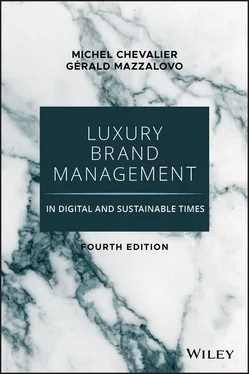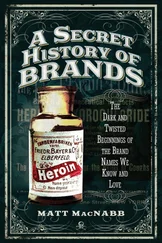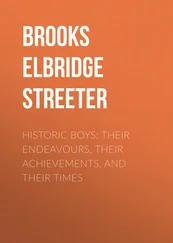Keeping Up with Social Trends.The importance of staying in touch with changing social trends is reflected in the experiences of some of the leading brands themselves. For example, at one time the sexy-chic positioning of Gucci met with strong approval from its target customer. Versace, too, was doing very well with the sexiness of its dresses and in its communication. Today the sexy-chic theme seems to be less attractive to the consumer, and Gucci has come to a much more classic and probably much younger and much more colorful positioning. Versace, however, failed to read the mood in the same way and didn't change, with the result that its sales fell considerably until the turnaround came from very sophisticated women's cocktail dresses and men's suits.
Paco Rabanne, with his glittering metallic dresses, was an icon of the spirit of sexual liberation that was all-pervasive around 1968 and met with strong interest from the public. Jane Fonda and Brigitte Bardot had special gowns made for them as a special commitment to a given way of life. Fashion magazines were showing his models and interviewing him for his views on the new social trends. At that time, his point of view mattered to the public. Today, though, few would be interested in his thoughts on what is happening in the world.
In using a luxury product, the consumer is making a claim to being different and special, at the forefront of social trends rather than appearing to be outside of society.
This fit with social trends and the spirit of the time is a very strong aspect of luxury. When people longed for a return to nature and a simpler society, they loved Danish designer Per Spook, who was designing natural-looking heavy wool-knit jackets and beige cotton skirts. When they wanted an extremely sexy look, they went for Versace. When the times become more traditional and conservative, with the emphasis on the mature woman, Chanel has a lot to offer.
With hindsight, it is clear that some brands have developed very quickly at one time and then declined, and not necessarily because their management was less effective and their marketing was off-base. It was simply a product of the changing times. Now, of course, good marketing is supposed to remain in line with consumer trends. But how far should a company go to adjust its product and brand positioning to the changes in society?
The Response to Changing Trends.As mentioned earlier, Paco Rabanne's appeal faded when his philosophy was deemed to be out of step with changing social trends that saw the advent of the sexy society of the late 1990s. He could have come to a sexy positioning and, indeed, many of the sophisticated metallic dresses of Versace could have been done by him. But this was not his style and he did not feel the need to do it.
Salvatore Ferragamo provides another interesting case. It developed from high-quality shoes to producing the finest silk ties and scarves on the market. A Ferragamo tie is immediately identifiable by its beautiful colors and its extremely fine prints, which could almost have come from an old Persian manuscript. But, now, the fashion is for plain jacquard silk ties. Should Salvatore Ferragamo change its product philosophy? The fact is that it has indeed introduced some jacquard silk ties, but the company is struggling to differentiate itself from its competitors.
We finish this section with a note to remind managers of the underlying uncertainty of the luxury business. Often, success (or the lack of it) is as much a product of the changing social environment as it is of individual managerial style.
It is necessary to describe the major operators in the field. Various articles say that the tendency is toward large groups and that individual companies don't stand a chance in the luxury market in the long run. Is this really the case?
What Is the Size of the Luxury Market?
As we said earlier, in luxury, size is relative. As there is very little data available on the size of the total market, we are obliged to come up with our own guesstimates of this activity; we start with the very precise estimates that are published each year by consulting firm Bain & Company, and are very precise.
It all depends, of course, on whether we consider luxury in its more limited scope (fashion, accessories including leather goods, cosmetics and fragrances, wines and spirits, etc.) or if we also include luxury cars (which Bain values at €500 billion), private airplanes, and travel, including hotels (which Bain values at €190 billion) and hospitality. In the larger category, the total turnover of the corporations manufacturing products or rendering direct services could be all the way to €1,200 billion. If we take the Bain figures for what they call “personal luxury,” we find the figures shown in Table 2.3.
We consider these sales statistics to be very precise and well analyzed, but we want to also include wines and spirits and tablewares (a total of €71 billion) in our tables. This is shown in Table 2.4.
Let us explain how our numbers differ from Bain's. We believe that their figures for accessories are very high but we don't want to depart from them. For wines and spirits, we considered “luxury wines” to be only wines that would retail for more than €10 a bottle. We have very different estimates for jewelry and watches because we decided to include in the jewelry those watches that were sold under a jewelry brand by a jeweler.
Table 2.3 Bain's Estimates of Business Size, 2018 (€ billion)
Source: Bain annual study on personal luxury, 2018.
| Apparel |
60 |
| Accessories |
75 |
| Jewelry and watches |
51 |
| Beauty |
51 |
| Total |
237 |
Table 2.4 Our Estimates of Basic Luxury Products Business Sales, 2019 (€ billion)
| Apparel |
60 |
| Accessories |
75 |
| Spirits and luxury wines |
65 |
| Perfumes and cosmetics |
65 |
| Watches |
26 |
| Jewelry |
45 |
| Tableware |
6 |
| Total |
342 |
Table 2.5 Estimates of the Respective Contributions of French and Italian Companies
Source: These figures are based on the authors' discussions with different industry specialists.
|
Total (€ billion) |
French (%) |
Italian (%) |
Others (%) |
| Ready-to-wear |
60 |
20 |
30 |
50 |
| Accessories |
75 |
25 |
35 |
40 |
| Alcohol and expensive wines |
65 |
15 |
10 |
75 |
| Fragrances and cosmetics |
65 |
35 |
5 |
60 |
| Watches |
26 |
5 |
5 |
90 |
| Jewelry |
45 |
7.5 |
5 |
87.5 |
| Tableware |
6 |
40 |
10 |
50 |
| Total |
342 |
|
|
|
Based on these estimates, we compare the relative size of the French and Italian companies, as set out in Table 2.5. Again, these figures are our own estimates and have been rounded up.
In the ready-to-wear category, Italy and France have 55% of the market between them, with Italy clearly leading the way. The others category comprises countries such as the United States and England. However, if we confine ourselves to luxury, and therefore do not take into account brands such as Liz Claiborne, Gap, or Banana Republic, the United States, with the exception of Ralph Lauren or Michael Kors, is not very strong in this category.
Читать дальше












